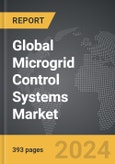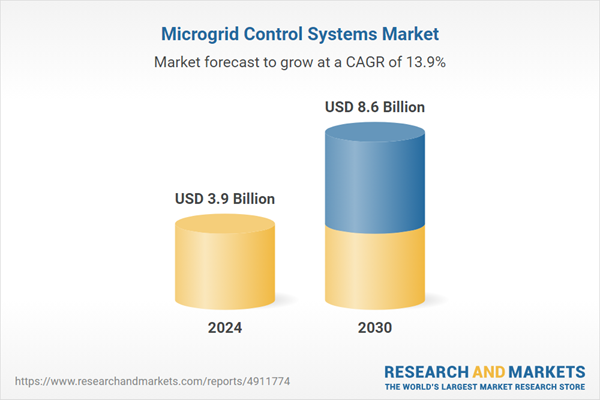The global market for Microgrid Control Systems was valued at US$3.9 Billion in 2024 and is projected to reach US$8.6 Billion by 2030, growing at a CAGR of 13.9% from 2024 to 2030. This comprehensive report provides an in-depth analysis of market trends, drivers, and forecasts, helping you make informed business decisions. The report includes the most recent global tariff developments and how they impact the Microgrid Control Systems market.
Technological advancements have significantly enhanced the capabilities of microgrid control systems. Modern systems leverage artificial intelligence (AI) and machine learning (ML) algorithms to predict energy consumption patterns, optimize energy storage usage, and dynamically adjust power generation. Real-time data analytics and advanced communication technologies enable precise monitoring and control, ensuring optimal performance and efficiency. Additionally, the integration of blockchain technology has emerged as a promising solution for enhancing the security and transparency of energy transactions within microgrids. These innovations facilitate the creation of highly efficient and flexible microgrids, capable of adapting to varying energy demands and generation conditions. Furthermore, advancements in hardware, such as more efficient inverters and controllers, have improved the reliability and scalability of microgrid control systems, making them suitable for a wide range of applications, from small residential setups to large industrial complexes.
The growth in the microgrid control systems market is driven by several factors, including the increasing adoption of renewable energy sources, the need for enhanced grid resilience, and advancements in energy management technologies. The global shift towards renewable energy has significantly boosted the demand for microgrids, which require sophisticated control systems to manage the variability and intermittency of renewable power. The growing frequency of extreme weather events and grid failures has underscored the importance of resilient power systems, further driving the adoption of microgrids and their control systems. Technological advancements, such as AI-driven predictive analytics and blockchain-based energy management, have also spurred market growth by enhancing the efficiency, reliability, and security of microgrid operations. Additionally, supportive government policies and incentives aimed at promoting renewable energy and grid modernization have provided a significant impetus for the development and deployment of microgrid control systems. The increasing focus on sustainability and the rising demand for decentralized energy solutions are expected to continue driving the expansion of the microgrid control systems market in the coming years.
Segments: Grid Type (Off-Grid, and On-Grid); Component (Hardware, and Software); and Application (Utilities, Institutes & Campuses, Industrial & Commercial, and Other Applications).
Geographic Regions/Countries: World; USA; Canada; Japan; China; Europe; France; Germany; Italy; UK; Rest of Europe; Asia-Pacific; Rest of World.
The analysts continuously track trade developments worldwide, drawing insights from leading global economists and over 200 industry and policy institutions, including think tanks, trade organizations, and national economic advisory bodies. This intelligence is integrated into forecasting models to provide timely, data-driven analysis of emerging risks and opportunities.
Global Microgrid Control Systems Market - Key Trends & Drivers Summarized
Microgrid control systems are sophisticated technologies designed to manage and optimize the operation of microgrids, which are localized grids that can operate independently or in conjunction with the main power grid. These systems ensure the efficient distribution of electricity generated from various sources, such as solar panels, wind turbines, and traditional generators, within the microgrid. They balance supply and demand, maintain voltage and frequency stability, and facilitate the integration of renewable energy sources. Microgrid control systems are crucial for enhancing the reliability and resilience of power supply, especially in remote areas, critical infrastructure, and during grid outages. By enabling seamless transitions between grid-connected and islanded modes, these systems ensure continuous power availability and improve overall energy security.Technological advancements have significantly enhanced the capabilities of microgrid control systems. Modern systems leverage artificial intelligence (AI) and machine learning (ML) algorithms to predict energy consumption patterns, optimize energy storage usage, and dynamically adjust power generation. Real-time data analytics and advanced communication technologies enable precise monitoring and control, ensuring optimal performance and efficiency. Additionally, the integration of blockchain technology has emerged as a promising solution for enhancing the security and transparency of energy transactions within microgrids. These innovations facilitate the creation of highly efficient and flexible microgrids, capable of adapting to varying energy demands and generation conditions. Furthermore, advancements in hardware, such as more efficient inverters and controllers, have improved the reliability and scalability of microgrid control systems, making them suitable for a wide range of applications, from small residential setups to large industrial complexes.
The growth in the microgrid control systems market is driven by several factors, including the increasing adoption of renewable energy sources, the need for enhanced grid resilience, and advancements in energy management technologies. The global shift towards renewable energy has significantly boosted the demand for microgrids, which require sophisticated control systems to manage the variability and intermittency of renewable power. The growing frequency of extreme weather events and grid failures has underscored the importance of resilient power systems, further driving the adoption of microgrids and their control systems. Technological advancements, such as AI-driven predictive analytics and blockchain-based energy management, have also spurred market growth by enhancing the efficiency, reliability, and security of microgrid operations. Additionally, supportive government policies and incentives aimed at promoting renewable energy and grid modernization have provided a significant impetus for the development and deployment of microgrid control systems. The increasing focus on sustainability and the rising demand for decentralized energy solutions are expected to continue driving the expansion of the microgrid control systems market in the coming years.
Report Scope
The report analyzes the Microgrid Control Systems market, presented in terms of units. The analysis covers the key segments and geographic regions outlined below.Segments: Grid Type (Off-Grid, and On-Grid); Component (Hardware, and Software); and Application (Utilities, Institutes & Campuses, Industrial & Commercial, and Other Applications).
Geographic Regions/Countries: World; USA; Canada; Japan; China; Europe; France; Germany; Italy; UK; Rest of Europe; Asia-Pacific; Rest of World.
Key Insights:
- Market Growth: Understand the significant growth trajectory of the Off-Grid segment, which is expected to reach US$5.7 Billion by 2030 with a CAGR of a 14.7%. The On-Grid segment is also set to grow at 12.6% CAGR over the analysis period.
- Regional Analysis: Gain insights into the U.S. market, valued at $1.2 Billion in 2024, and China, forecasted to grow at an impressive 16.8% CAGR to reach $1.9 Billion by 2030. Discover growth trends in other key regions, including Japan, Canada, Germany, and the Asia-Pacific.
Why You Should Buy This Report:
- Detailed Market Analysis: Access a thorough analysis of the Global Microgrid Control Systems Market, covering all major geographic regions and market segments.
- Competitive Insights: Get an overview of the competitive landscape, including the market presence of major players across different geographies.
- Future Trends and Drivers: Understand the key trends and drivers shaping the future of the Global Microgrid Control Systems Market.
- Actionable Insights: Benefit from actionable insights that can help you identify new revenue opportunities and make strategic business decisions.
Key Questions Answered:
- How is the Global Microgrid Control Systems Market expected to evolve by 2030?
- What are the main drivers and restraints affecting the market?
- Which market segments will grow the most over the forecast period?
- How will market shares for different regions and segments change by 2030?
- Who are the leading players in the market, and what are their prospects?
Report Features:
- Comprehensive Market Data: Independent analysis of annual sales and market forecasts in US$ Million from 2024 to 2030.
- In-Depth Regional Analysis: Detailed insights into key markets, including the U.S., China, Japan, Canada, Europe, Asia-Pacific, Latin America, Middle East, and Africa.
- Company Profiles: Coverage of players such as Hitachi Ltd., Honeywell International, Inc., ABB Ltd., Eaton Corporation PLC, Emerson Electric Company and more.
- Complimentary Updates: Receive free report updates for one year to keep you informed of the latest market developments.
Some of the 69 companies featured in this Microgrid Control Systems market report include:
- Hitachi Ltd.
- Honeywell International, Inc.
- ABB Ltd.
- Eaton Corporation PLC
- Emerson Electric Company
- Caterpillar, Inc.
- Cummins, Inc.
- LG CNS
- Ameresco, Inc.
- GE Grid Solutions
- ETAP
- Emacx System, Inc.
- DEIF A/S
- EMTP
- MicroGrid, Inc.
Tariff Impact Analysis: Key Insights for 2025
Global tariff negotiations across 180+ countries are reshaping supply chains, costs, and competitiveness. This report reflects the latest developments as of April 2025 and incorporates forward-looking insights into the market outlook.The analysts continuously track trade developments worldwide, drawing insights from leading global economists and over 200 industry and policy institutions, including think tanks, trade organizations, and national economic advisory bodies. This intelligence is integrated into forecasting models to provide timely, data-driven analysis of emerging risks and opportunities.
What’s Included in This Edition:
- Tariff-adjusted market forecasts by region and segment
- Analysis of cost and supply chain implications by sourcing and trade exposure
- Strategic insights into geographic shifts
Buyers receive a free July 2025 update with:
- Finalized tariff impacts and new trade agreement effects
- Updated projections reflecting global sourcing and cost shifts
- Expanded country-specific coverage across the industry
Table of Contents
I. METHODOLOGYMII. EXECUTIVE SUMMARY2. FOCUS ON SELECT PLAYERSIII. MARKET ANALYSISIV. COMPETITION
1. MARKET OVERVIEW
3. MARKET TRENDS & DRIVERS
4. GLOBAL MARKET PERSPECTIVE
UNITED STATES
CANADA
JAPAN
CHINA
EUROPE
FRANCE
GERMANY
ITALY
UNITED KINGDOM
REST OF EUROPE
ASIA-PACIFIC
REST OF WORLD
Companies Mentioned (Partial List)
A selection of companies mentioned in this report includes, but is not limited to:
- Hitachi Ltd.
- Honeywell International, Inc.
- ABB Ltd.
- Eaton Corporation PLC
- Emerson Electric Company
- Caterpillar, Inc.
- Cummins, Inc.
- LG CNS
- Ameresco, Inc.
- GE Grid Solutions
- ETAP
- Emacx System, Inc.
- DEIF A/S
- EMTP
- MicroGrid, Inc.
Table Information
| Report Attribute | Details |
|---|---|
| No. of Pages | 393 |
| Published | April 2025 |
| Forecast Period | 2024 - 2030 |
| Estimated Market Value ( USD | $ 3.9 Billion |
| Forecasted Market Value ( USD | $ 8.6 Billion |
| Compound Annual Growth Rate | 13.9% |
| Regions Covered | Global |









